Marc Abrahams's Blog, page 253
September 4, 2016
New take on old research on smiling might make people smile, then think
Renowned research about smiling is, suddenly, making some scientists smirk. The British Psychological Society’s Research Digest explains:
No reason to smile – Another modern psychology classic has failed to replicateBy Christian Jarrett
The great American psychologist William James proposed that bodily sensations – a thumping heart, a sweaty palm – aren’t merely a consequence of our emotions, but may actually cause them. In his famous example, when you see a bear and your pulse races and you start running, it’s the running and the racing pulse that makes you feel afraid.
Consistent with James’ theory (and similar ideas put forward even earlier by Charles Darwin), a lot of research has shown that the expression on our face seems not only to reflect, but also to shape how we’re feeling. One of the most well-known and highly cited pieces of research to support the “facial feedback hypothesis” was published in 1988 and involved participants looking at cartoons while holding a pen either between their teeth, forcing them to smile, or between their lips, forcing them to pout. Those in the smile condition said they found the cartoons funnier.
But now an attempt to replicate this modern classic of psychology research, involving 17 labs around the world and a collective subject pool of 1894 students, has failed. “Overall, the results were inconsistent with the original result,” the researchers said.
The replication effort which has been published online in Perspectives on Psychological Science attempted to stay extremely close to the original 1988 study…

September 3, 2016
They made an electronic leech
This paper gives details of the design, and the actual building and testing, of an electronic leech:
“Diseño de una sanguijuela electrónica” [Design of an electronic leech].[Article in Spanish], Rev Invest Clin. 2014 Jul;66 Suppl 1:S94-9.
Authors: Lomelí-Mejía PA, Domínguez-Rubio R, Espinosa-Gutiérrez A, Lecona-Butrón H, Rodríguez-Reyna RM.
The authors, at Laboratorio de Biomecánica, Instituto Nacional de Rehabilitación, explain: “This research presents the development of a continual suction electromechanical device (CSED) which emulates the feeding characteristics of a medicinal leech to drain body fluids. After the research, design and building of the device, its performance in normal conditions with fluids of different viscosity was evaluated. Finally, the device was submitted to a test of blood draining in three adult male rabbits NZW with a weight of three kilograms, obtaining drain.”
(Thanks to Irma Aguilar-Delfin for bringing this to our attention.)

September 1, 2016
Why do people go to pop concerts?
Technological innovations have facilitated widespread illegal downloading of recorded music (which points towards a decreased willingness to pay for music) nevertheless, people still go to pop concerts – which they usually have to pay for – raising the question ‘Why?’
 Behavioural scientist Dr Steven Caldwell Brown [pictured] from The University of Edinburgh, Scotland, (and also Ragged University) and colleague Dr Don Knox of Glasgow Caledonian University, Scotland provide answers in a new paper for the journal Musicae Scientiae entitled ‘Why go to pop concerts? The motivations behind live music attendance’
Behavioural scientist Dr Steven Caldwell Brown [pictured] from The University of Edinburgh, Scotland, (and also Ragged University) and colleague Dr Don Knox of Glasgow Caledonian University, Scotland provide answers in a new paper for the journal Musicae Scientiae entitled ‘Why go to pop concerts? The motivations behind live music attendance’
Drawing from a sample of 249 participants (55.02% female) with a mean age of 26.49, an open-ended questionnaire was analysed thematically – with reference to a complex mix of ‘core drivers’, including experience, engagement, novelty and practical aspects. To briefly sum up :
“The results highlight that participants want to ‘be there’.”
Also see : The Unexpected Downside of Expertise

August 31, 2016
Does an apple a day improve a woman’s sex life? [podcast #79]
The question “Does an apple a day improve a woman’s sex life?” anchors this week’s Improbable Research podcast.
SUBSCRIBE on Play.it, iTunes, or Spotify to get a new episode every week, free.
This week, Marc Abrahams — with dramatic readings by Yale/MIT/Harvard biomedical researcher Chris Cotsapis — tells about:
Does an apple a day improve a woman’s sex life? — “Apple Consumption is Related to Better Sexual Quality of Life in Young Women,” Tommaso Cai, Mauro Gacci, Fulvio Mattivi, Nicola Mondaini, Serena Migno, Vieri Boddi, Paolo Gacci, Beatrice Detti, Paolo Gontero, Stefano Chiodini, Liliana Mereu, Saverio Tateo, Sandra Mazzoli, Gianni Malossini, and Riccardo Bartoletti, Archives of Gynecology and Obstetrics, vol. 290, February 2014, pp. 1-6. The researchers are based in Italy. The study also involves chocolate.
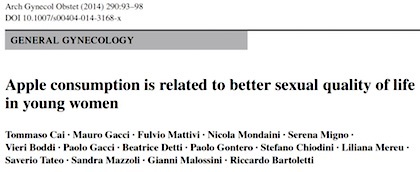
Apples.
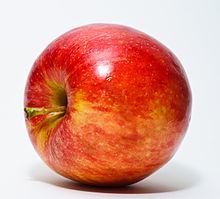 The mysterious John Schedler or the shadowy Bruce Petschek perhaps did the sound engineering this week.
The mysterious John Schedler or the shadowy Bruce Petschek perhaps did the sound engineering this week.
The Improbable Research podcast is all about research that makes people LAUGH, then THINK — real research, about anything and everything, from everywhere —research that may be good or bad, important or trivial, valuable or worthless. CBS distributes it, on the CBS Play.it web site, and on iTunes and Spotify).

August 29, 2016
Who Is the Most Famous Person in the World, Statistically?
Fame has been newly measured by Eric Schulman, continuing the series of studies he began in 2001. We are famously proud to publish the new paper here, as famously as we were to publish the earlier papers. Read the paper here, below, and if you like, also download it in PDF form: MEASURING FAME-part2-2016-09.
***
M EASURING F AME Q UANTITATIVELY . V.W HO ‘ S THE M OST F AMOUS OF T HEM A LL ? (P ART 2)
by Eric Schulman, Alexandria, Virginia
Abstract Donald Trump.
1. Introduction
In this fifth paper on measuring fame quantitatively, we summarize the changes in fame over the past 15 years and identify the person we believe to be the most famous person in the world at the present time. Our previous research (Schulman 1999, Schulman and Boissier 2001, Schulman 2006, and Schulman 2009) showed that many people are famous to some extent and that Internet search engines can measure the exact fame of such people by comparing the number of search engine hits for the person to the number of search engine hits for a universal standard of fame.
2. Methods
We use the methods of Schulman (2009) to measure the current fame of the 49 subjects in the longitudinal study first described in (Schulman 2006), who asserted that people we perceive as ‘A’ List celebrities are on average ten times more famous than people we perceive as ‘B’ List celebrities, who are on average ten times more famous than people we perceive as ‘C’ List celebrities, and so on. The 49 subjects are from seven different fields (business, film, music, politics, religion, science, and sports) and their fame has been measured five times between 2001 and the present using the logarithmic international standard unit of fame, the dBHa (Schulman 2009):
fame(dBHa) = 10 log [fame(Ha)],
where fame(Ha) is the number of Google hits for the person divided by the number of Google hits for George Harrison, the archetypal ‘B’ List celebrity whose fame is 0 dBHa by definition. Other celebrities are therefore classified as follows:
‘A+’ List fame > +15 dBHa
‘A’ List +5 dBHa < fame < +15 dBHa
‘B’ List –5 dBHa < fame < +5 dBHa
‘C’ List –15 dBHa < fame < –5 dBHa
‘D’ List –25 dBHa < fame < –15 dBHa
‘E’ List –35 dBHa < fame < –25 dBHa
‘F’ List –45 dBHa < fame < –35 dBHa
‘G’ List –55 dBHa < fame < –45 dBHa
‘H’ List fame < –55 dBHa
This factor of ten difference between categories is analogous to the concept behind the Richter magnitude scale, in which a 6.5-magnitude earthquake has a shaking amplitude that is ten times larger than that of a 5.5-magnitude earthquake.
3. Results
Table 1 shows our classification of the 49 longitudinal study subjects since January 2001.
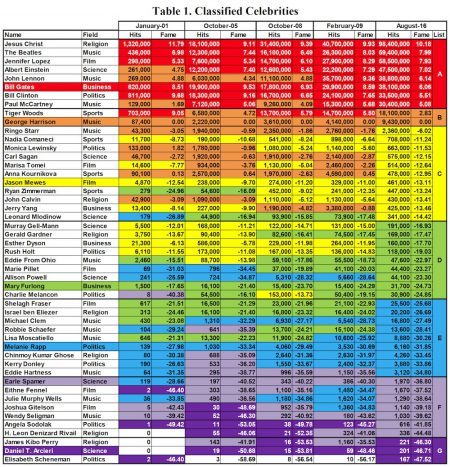
The Hits columns show the number of Google hits that each subject had in January 2001, October 2005, October 2008, February 2009, and August 2016; the Fame columns show their fame in dBHa; and the List column shows their celebrity category as of August 2016. The Hits, Fame, and List entries are color-coded so that ‘A’ List celebrity entries are red, ‘B’ List celebrity
entries are orange, ‘C’ List celebrity entries are yellow, ‘D’ List celebrity entries are green, ‘E’ List celebrity entries are blue, ‘F’ List celebrity entries are called indigo but are really light purple, ‘G’ List celebrity entries are called violet but are really dark purple, and ‘H’ List celebrity entries are called ultraviolet but are really white. The names and fields of one typical celebrity in each category are similarly colored (there were no ‘F’ or ‘G’ celebrities who have been in those categories since 2001, but each category had one subject who has been in that category since 2005).
Note that all the fame observations in Table 1 were taken in the United States and the results in other countries could be different. In order to assess the potential impact of this effect, fame observations of seven ‘A’ List through ‘E’ List celebrities were made in Australia and the United Kingdom. The Australia and United Kingdom fame of six of the seven celebrities was within 1% of the United States fame. The seventh celebrity, George Harrison, was 10% less famous in Australia and 13% less famous in the United Kingdom compared to the United States. It is unclear why the archetypal ‘B’ List celebrity would have the highest fame variance. Researchers outside the United States are encouraged to study this issue more thoroughly.
4. Discussion
Table 1 provides a wealth of data worthy of comment. For example, the Lennon Theorem (1966) stated that The Beatles were “more popular than Jesus,” but this has not been true in any of the fame observations since 2001. A determination of whether the Lennon Theorem was true in 1966 is beyond the scope of this paper, but we can state that The Beatles are not currently more popular than Cristiano Ronaldo, who is 1.6 dBHa more famous. Another item of note is that the percentage of ‘B’ List celebrities in the study has decreased dramatically, from 18% in 2005 to just 4% in 2016. This is even more remarkable because of the fact that there must, by definition, be at least one ‘B’ List celebrity in the study (George Harrison). Of the nine ‘B’ List celebrities from 2005, one (John Lennon) has become an ‘A’ List celebrity and six have become ‘C’ List celebrities. The sole ‘H’ List celebrity from 2005 to 2009, Elisabeth Scheneman, is now a Chief of Staff at the Pennsylvania Department of Health and has become a ‘G’ List celebrity.
Although it is simple to determine who the most famous is among a particular group of subjects, determining the most famous person of all is non-trivial. Schulman (2009) concluded that Barack Obama was the most famous person in the world in February 2009, and since his fame was greater than +15 dBHa (+16.3 dBHa), he was in a celebrity category by himself: an ‘A+’ List celebrity. This is no longer the case, as his fame has dropped to +12.1 dBHa over the past seven and a half years and he is now an ‘A’ List celebrity. In fact, he has been overtaken by one of the people seeking his job: Donald Trump now has a fame of +14.0 dBHa (for those who are curious, Hillary Clinton has a fame of +12.0 dBHa, Gary Johnson has a fame of –1.9 dBHa, Jill Stein has a fame of –2.7 dBHa, and Evan McMullin has a fame of –10.7 dBHa).
5. Conclusion
Donald Trump is the most famous person in the world, but he is not as famous as Barack Obama was in 2009.

August mini-AIR: Worst Myopia Claw; Kissing, then Redness, etc.
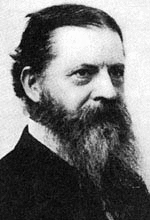 The August issue of mini-AIR (our monthly e-mail newsletter) just went out. (mini-AIR is a wee little supplement to the magazine itself). Topics include:
The August issue of mini-AIR (our monthly e-mail newsletter) just went out. (mini-AIR is a wee little supplement to the magazine itself). Topics include:
Worst Myopia Claw Intraocular Lens
Kissing, Then Redness
Heads Versus Risk Limerick Contest
and more
It also has info about upcoming events.
Mel [pictured here] says, “It’s swell.”
mini-AIR is the simplest way to keep informed about Improbable and Ig Nobel news and events.
Want to mini-AIR e-mailed to you every month? Just opt in.

The pleasure of being nasty
Dr. Klaus Abbink (pictured) of Monash Business School has (along with colleague Prof. Dr. Abdolkarim Sadrieh) experimentally examined the question of pleasure derived from deliberate nastiness – specifically with regard to joy-of-destruction.
“
In the joy-of-destruction game that we introduce, players can burn each other’s money, but we have removed all conventional reasons to do so. No material gain is achieved, no wrongdoing is punished, no inequality is reduced. Nevertheless, we observe a substantial incidence of nasty behavior in our hidden treatment, where spiteful actions could be covered by random destruction. When destruction is open, it rapidly goes away, but the treatment difference shows that this decline is due to fear of retaliation, not due to kindness.”
Their paper on the subject, The Pleasure of Being Nasty was published in Economics Letters, Volume 105, Issue 3, December 2009, Pages 306–308. A full copy of the work may be found here.

August 28, 2016
“Promise and Ontological Ambiguity in the In vitro Meat Imagescape”
Promise and ontological ambiguity in the in vitro meat imagescape is focus of a newly published study called “Promise and Ontological Ambiguity in the In vitro Meat Imagescape.” The study is:
“Promise and Ontological Ambiguity in the In vitro Meat Imagescape: From Laboratory Myotubes to the Cultured Burger,” Neil Stephens and Martin Ruivenkamp, Science as Culture, vol. 25, no. 3, 2016. The authors, at Brunel University London, Middlesex, UK, and University of Applied Sciences, Nijmegen, The Netherlands, explain:
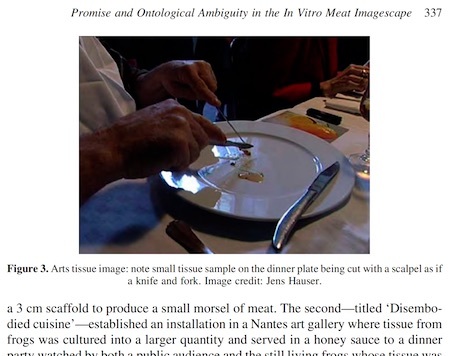
“In vitro meat (IVM), also known as cultured meat, involves growing cells into muscle tissue to be eaten as food. The technology had its most high-profile moment in 2013 when a cultured burger was cooked and tasted in a press conference. Images of the burger featured in the international media and were circulated across the Internet. These images—literally marks on a two-dimensional surface—do important work in establishing what IVM is and what it can do. A combination of visual semiotics and narrative analysis shows that images of IVM afford readings of their story that are co-created by the viewer. Before the cultured burger, during 2011, images of IVM fell into four distinct categories: cell images, tissue images, flowcharts, and meat in a dish images. The narrative infrastructure of each image type affords different interpretations of what IVM can accomplish and what it is. The 2013 cultured burger images both draw upon and depart from these image types in an attempt to present IVM as a normal food stuff, and as ‘matter in place’ when placed on the plate.”
(Thanks to Tom Gill for bringing this to our attention.)

August 27, 2016
Pithy thesis summaries, by truthful thesis authors
Laugh, if you will, at these pithy summaries, in plain language, of academic theses. Who wrote the summaries? The people who wrote the theses — each summarizing their own work. It’s all on the web site LOLmythesis.com
(Thanks to Ivan Oransky for bringing this to our attention.)

August 25, 2016
Marijuana improves night vision of tadpoles, study suggests
Marijuana improves night vision of tadpoles, suggests a newly published study: “Endocannabinoid signaling enhances visual responses through modulation of intracellular chloride levels in retinal ganglion cells,” Loïs S Miraucourt, Jennifer Tsui, Delphine Gobert, Jean-François Desjardins, Anne Schohl, Mari Sild, Perry Spratt, Annie Castonguay, Yves De Koninck, Nicholas Marsh-Armstrong, Paul W Wiseman, and Edward S Ruthazer, eLife, 2016;5:e15932.
The authors, at McGill University, Canada; University of La Verne, United States; University of California, San Francisco, United States; Université Laval, Canada; Johns Hopkins University School of Medicine, United States; Kennedy Krieger Institute, United States, report:
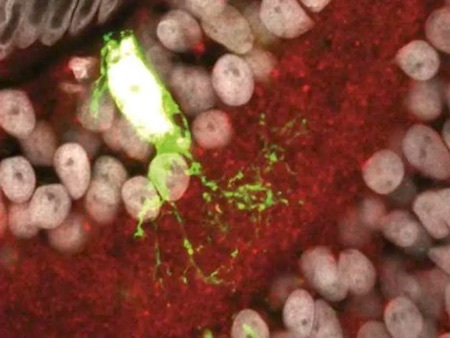
“Type 1 cannabinoid receptors (CB1Rs) are widely expressed in the vertebrate retina, but the role of endocannabinoids in vision is not fully understood. Here, we identified a novel mechanism underlying a CB1R-mediated increase in retinal ganglion cell (RGC) intrinsic excitability acting through AMPK-dependent inhibition of NKCC1 activity. Clomeleon imaging and patch clamp recordings revealed that inhibition of NKCC1 downstream of CB1R activation reduces intracellular Cl− levels in RGCs, hyperpolarizing the resting membrane potential. We confirmed that such hyperpolarization enhances RGC action potential firing in response to subsequent depolarization, consistent with the increased intrinsic excitability of RGCs observed with CB1R activation. Using a dot avoidance assay in freely swimming Xenopus tadpoles, we demonstrate that CB1R activation markedly improves visual contrast sensitivity under low-light conditions.”
Charlie Fidelman provides further details, in the Montreal Gazette, under the headline “Pot improves night vision — in tadpoles, study finds“.
(Thanks to Christie Rowe for bringing this to our attention.)
BONUS (Distantly related): The 2000 Ig Nobel Prize for biology was awarded to Richard Wassersug of Dalhousie University (now at U British Columbia) for his first-hand report, “On the Comparative Palatability of Some Dry-Season Tadpoles from Costa Rica.” [Published in The American Midland Naturalist, vol. 86, no. 1, July 1971, pp. 101-9.]

Marc Abrahams's Blog
- Marc Abrahams's profile
- 14 followers






